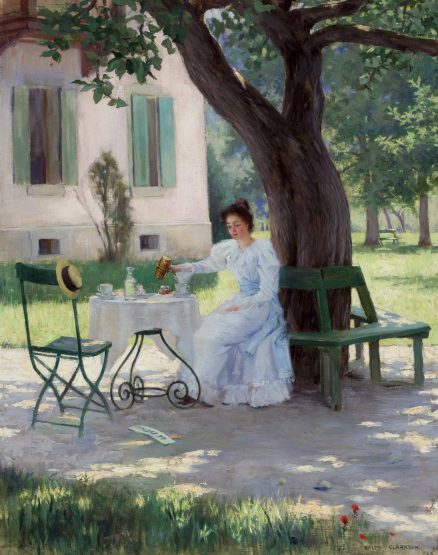- Categories
- Landscapes
- Women
- Zoom in on Artwork
- Print Page
- Email Page to Friend
At the center of Ralph Clarkson’s summertime image of an open-air (au frais) breakfast is a slender young woman, gowned in white, pouring coffee at a small white-draped table in the dappled shade of a large tree. A second coffee cup, a straw boater hat hanging from the back of an empty chair and, on the ground nearby, a folded copy of the French daily newspaper Le Figaro all testify to the recent presence of a male companion. The woman’s loose white gown and lack of a hat—an accessory once considered essential for appearing in public—mark the setting as one of private domesticity, as underscored by the house in the background.
The painting’s bright colors and contrasts of light and shade evince Clarkson’s awareness of French Impressionism; at the same time, its blended brushwork and solid rendering of forms demonstrate his grounding in traditional pictorial values. During his student years in Paris in the mid-1880s, according to biographer Richard Teutsch, the artist was inspired to paint outdoors by the “luminosity” of the paintings of Claude Monet and Edouard Manet.i Clarkson visited Switzerland sometime between 1892 and 1894, when he painted this scene in the village of Bex, a few miles from the French border, as indicated by the inscription below his signature at the lower right. The artist was accompanied by his wife, Frances Rose Calhoun, whom he married in 1890. The daughter of a Hartford, Connecticut, judge, she was described as a cultivated woman who played a supportive role in her husband’s career and she also may have modeled for him, perhaps for this painting. It was reproduced in the Chicago Tribune in 1901 with the title In a Swiss Garden.ii
Café au lait au frais was shown in the Art Institute of Chicago’s seventh annual exhibition for American artists in late 1894, when Clarkson was still abroad. It was the first painting he showed at the Art Institute, marking the beginning of his successful career in the city. Thereafter, the artist exhibited few figural scenes, concentrating instead on landscapes and, ultimately, portraits.
Wendy Greenhouse, PhD
Donated by M. Christine Schwartz to the Newberry Library, Chicago, Illinois, in 2021
i Richard Teutsch, “Ralph Clarkson 1861–1942,” Tri-Color Magazine 33 (May 1942): 6-7, 36, in Union League Club of Chicago curatorial files.
ii “Paintings by Ralph Clarkson,” Chicago Tribune, May 26, 1901 (reference courtesy Illinois Historical Art Project).
